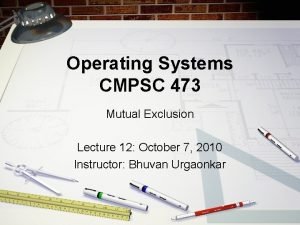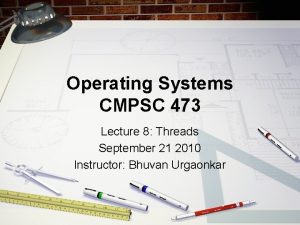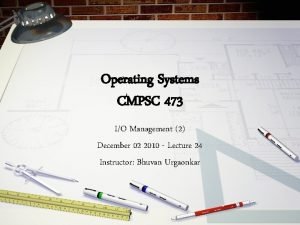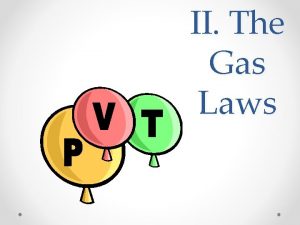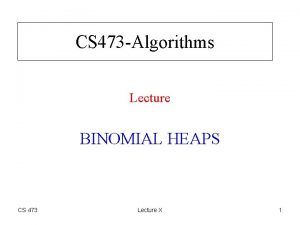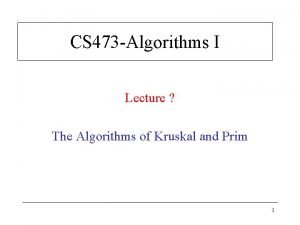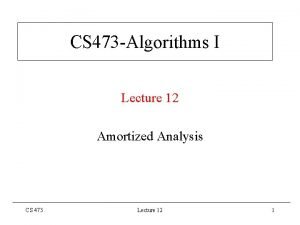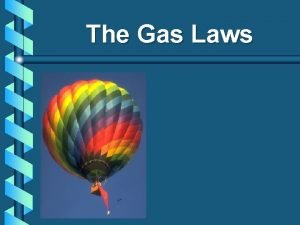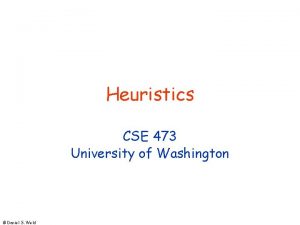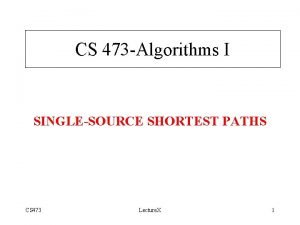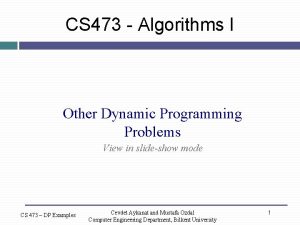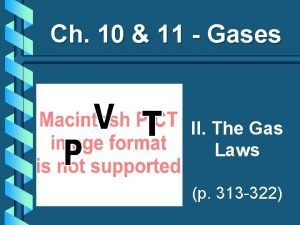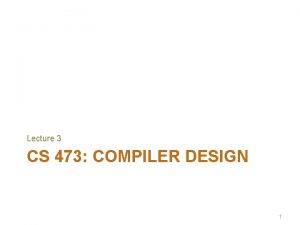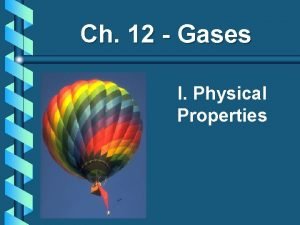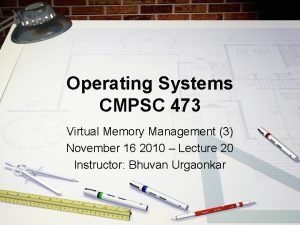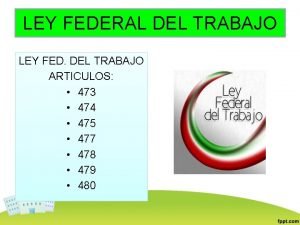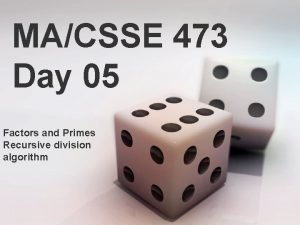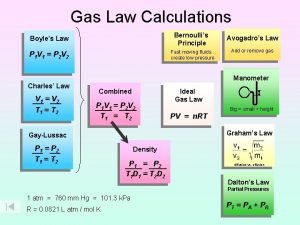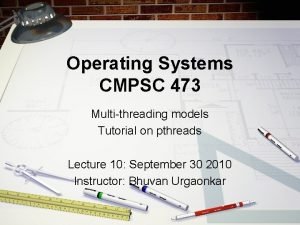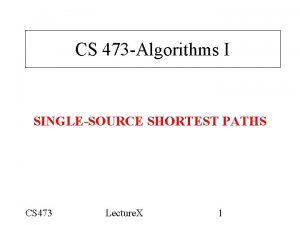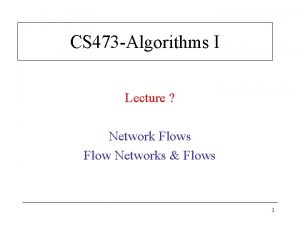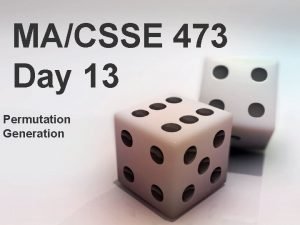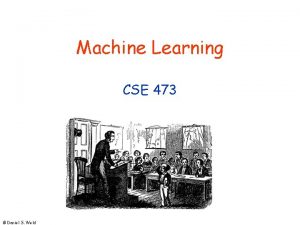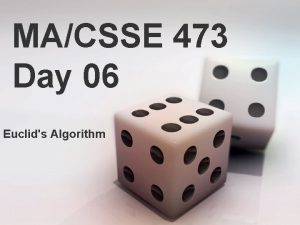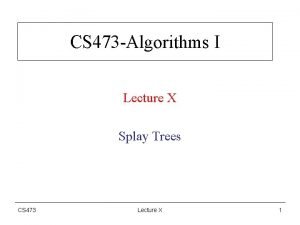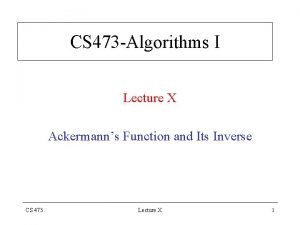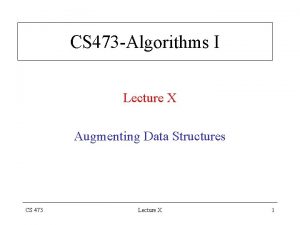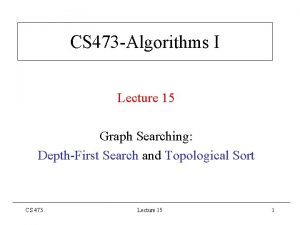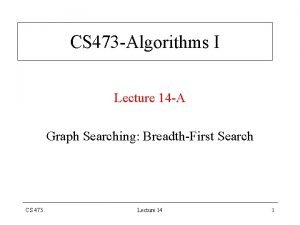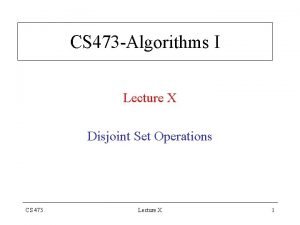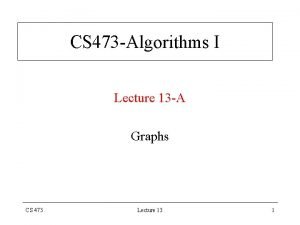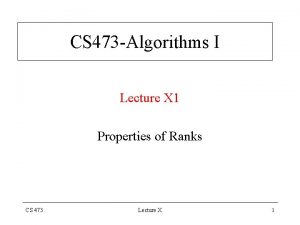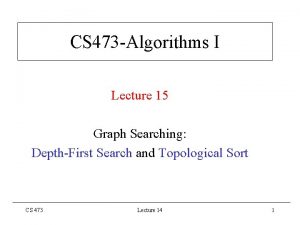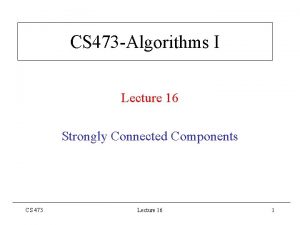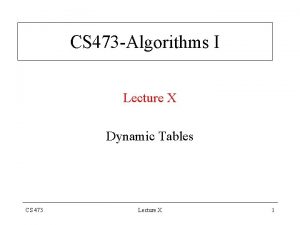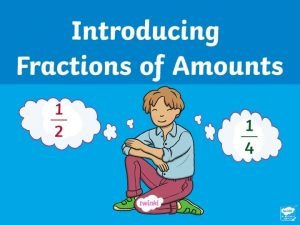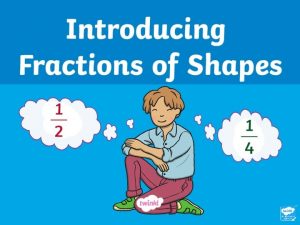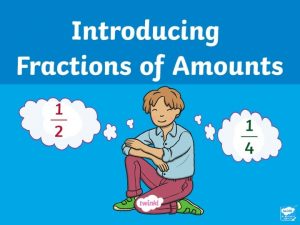CS 473 Algorithms I Lecture Network Flows Finding

![FORD-FULKERSON METHOD / ALGORITHM • iterative algorithm: start with initial flow f =[0] with FORD-FULKERSON METHOD / ALGORITHM • iterative algorithm: start with initial flow f =[0] with](https://slidetodoc.com/presentation_image_h2/4c488746a6b52cce6bd6fa7579841508/image-2.jpg)




























- Slides: 30

CS 473 -Algorithms I Lecture ? Network Flows Finding Max Flow 1
![FORDFULKERSON METHOD ALGORITHM iterative algorithm start with initial flow f 0 with FORD-FULKERSON METHOD / ALGORITHM • iterative algorithm: start with initial flow f =[0] with](https://slidetodoc.com/presentation_image_h2/4c488746a6b52cce6bd6fa7579841508/image-2.jpg)
FORD-FULKERSON METHOD / ALGORITHM • iterative algorithm: start with initial flow f =[0] with |f| = 0 – at each iteration, increase | f | by finding an augmenting path – repeat this process until no augmenting path can be found – by max-flow min-cut thm: upon termination this process yields a max flow FORD-FULKERSON-METHOD(G, s, t) initialize flow f to 0 while an augmenting path p do augment flow f along path p return f CS 473 Lecture ? 2

FORD-FULKERSON METHOD / ALGORITHM • basic Ford-Fulkerson Algorithm: data structures – note (u, v) Ef only if (u, v) E or (v, u) E – maintain an adj-list representation of directed graph G' = (V', E'), where • E' = {(u, v): (u, v) E or (v, u) E}, i. e. , – for each v Adj[u] in G' maintain the record v f(u, v) cf (u, v) – note: G' used to represent both G and Gf , i. e. , for any edge (u, v) E' • c[u, v] > 0 (u, v) E and cf [u, v] > 0 (u, v) Ef CS 473 Lecture ? 3

FORD-FULKERSON METHOD / ALGORITHM FORD-FULKERSON (G', s, t) for each edge (u, v) E' do f [u, v] ← 0 cf [u, v] ← 0 Gf ← COMPUTE-GF(G', f) while an s t path p in Gf do cf (p) ← min {cf [u, v]: (u, v) p} for each edge (u, v) p do f [u, v] ← f [u, v] + cf (p) CANCEL(G', u, v) Gf ← COMPUTE-GF(G', f) CS 473 COMPUTE-GF (G', f) for each edge (u, v) E' do if c[u, v] – f [u, v] > 0 then cf [u, v] ← c[u, v] – f[u, v] else cf [u, v] ← 0 return G' CANCEL (G', u, v) min ← {f [u, v], f [v, u]} f [u, v] ← f [u, v] – min f [v, u] ← f [v, u] – min Lecture ? 4

FORD-FULKERSON ALGORITHM • augmenting path in Gf is chosen arbitrarily • performance if capacities are integers: O(E |f*|) – while-loop: time to find s t path in Gf = O(E') = O(E) – # of while-loop iterations: ≤ |f*|, where f* = max flow • so, running time is good if capacities are integers and |f*| is small CS 473 Lecture ? 5

FORD-FULKERSON ALGORITHM f 0 0/100 s 0/100 u G f 0 0/100 0/1 v 100 t u 1 s 100 0/100 v t 100 p = < s, u, v, t > cf (p) = 1 | f 1 | = | f 0 | + | fp | = 0+1 = 1 CS 473 Lecture ? 6

FORD-FULKERSON ALGORITHM f 1 1/100 s 0/100 u G f 1 0/100 1/1 v u 99 t s 100 1/100 1 t 99 v 1 p = < s, v, u, t > cf (p) = 1 | f 2 | = | f 1 | + | fp | = 1+1 = 2 CS 473 Lecture ? 7

FORD-FULKERSON ALGORITHM f 2 1/100 s 1/100 u G f 2 1/100 0/1 v u 99 t 1 s 1 99 1 1/100 99 1 t 99 v 1 p = < s, u, v, t > cf (p) = 1 | f 3 | = | f 2 | + | fp | = 2+1 = 3 CS 473 Lecture ? 8

FORD-FULKERSON ALGORITHM f 3 2/100 s 1/100 u G f 3 1/100 1/1 v u 98 t 2 s 1 99 1 2/100 99 1 t 98 v 2 p = < s, v, u, t > cf (p) = 1 | f 4 | = | f 3 | + | fp | = 3+1 = 4 CS 473 Lecture ? 9

FORD-FULKERSON ALGORITHM • choose p = < s, u, v, t > in odd iterations • choose p = < s, v, u, t > in even iterations – 200 augmentations to reach |f*| = 200 • might never terminate for non-integer capacities • efficient algorithms: – augment along max-capacity path in Gf: not mentioned in textbook – augment along breadth-first path in Gf: Edmonds-Karp algorithm O(VE 2) CS 473 Lecture ? 10

EDMONDS-KARP ALGORITHM • def: δf (s, v) = shortest path distance from s to v in Gf – unit edge weights in Gf δf (s, v) = breadth-first distance from s to v in Gf • L 7: v V – {s, t}; δ (s, v) in Gf’s increases monotonically with each augmentation • proof: suppose – (i) a flow f on G induces Gf – (ii) fp along an augmenting path in Gf produces f’ = f + fp on G – (iii) f’ on G induces Gf’ • notation: δ(s, v) = δf (s, v) and δ’(s, v) = δf’ (s, v) CS 473 Lecture ? 11

ANALYSIS OF EDMONDS-KARP ALGORITHM • want to prove: δ' (s, v) ≥ δ(s, v) v V – {s, t} • for contradiction: assume δ'(s, v) < δ(s, v) for some v • without loss of generality: assume δ' (s, v) is minimal over all such vertices – i. e. , δ' (s, v) < δ' (s, u) u V – {s, t} δ' (s, u) < δ(s, u) – thus δ' (s, u) < δ' (s, v) δ' (s, u) ≥ δ(s, u) (1) CS 473 Lecture ? 12

ANALYSIS OF EDMONDS-KARP ALGORITHM • consider a shortest s v path p': s u → v in Gf’ Øδ'(s, u) = δ'(s, v) – 1 by “subpath is also a shortest path” δ' (s, u) < δ' (s, v) by (1), δ' (s, u) ≥ δ(s, u) (2) Øconsider this edge (u, v) Ef ': question: was (u, v) Ef ? ØYES: i. e. , (u, v) Ef ' and (u, v) Ef ; note f(u, v) < c(u, v) • δ(s, v) ≤ δ(s, u) + 1 by triangle inequality ≤ δ' (s, u) + 1 by (2) = δ' (s, v) ≥ δ(s, v) contradiction CS 473 Lecture ? 13

ANALYSIS OF EDMONDS-KARP ALGORITHM • NO: i. e. , (u, v) Ef ' but (u, v) Ef ; note f(u, v)=c(u, v) – fp pushes flow back along edge (u, v) (v, u) p in Gf – i. e. , augmenting path p is of the form p = s v → u t – note: p is a breadth-first path from s to t (Edmond-Karp algorithm) – δ(s, v) = δ(s, u) – 1 by “subpath is also a shortest path” ≤ δ' (s, u) – 1 by (2) = (δ' (s, v) – 1 by “subpath is also a shortest path” = δ' (s, v) – 2 < δ'(s, v)Lecture ≥ δ(s, v) contradiction 14 CS 473 ?

ANALYSIS OF EDMONDS-KARP ALGORITHM • what is the bound on the total # of augmentations? • def: an edge (u, v) in Gf is critical on an augmenting path p in Gf if cf (u, v) = cf (p) • at least one edge on an augmenting path must be critical • a critical edge disappears from Gf after the augmentation – f '(u, v) = (f+fp)(u, v) = f (u, v) + fp(u, v) = f (u, v) + (c(u, v) – f (u, v)) = c(u, v) cf ' (u, v) = c'(u, v) – f '(u, v) = c(u, v) – c(u, v) = 0 CS 473 Lecture ? 15

ANALYSIS OF EDMONDS-KARP ALGORITHM • Thm: number of flow augmentations is O(EV) • proof: find a bound on the number of times an edge (u, v) becomes critical – let (u, v) becomes critical the first time along path = s u → v t in Gf p • δ(s, v) = δ(s, u) + 1 (1), since p is a shortest path – then (u, v) disappears from the residual network – (u, v) can reappear an another augmenting path • only after net flow from u to v is decreased – this only happens if (v, u) appears on an augmenting path CS 473 Lecture ? 16

ANALYSIS OF EDMONDS-KARP ALGORITHM • assume this event occurs along a path p' = s u → v t in Gf ' later – δ'(s, u) = δ'(s, v) + 1 since p' = s u → v ≥ δ(s, v) + 1 by L 7 = (δ(s, u) + 1 since p' = s u → v = δ(s, u) + 2 δ' (s, u) ≥ δ(s, u) + 2 t is a shortest path • i. e. , δ(s, u) increase by ≥ 2 each time (u, v) becomes critical, except the first time • thus each edge (u, v) can become critical at most O(V) times, since – 1 ≤ δ(s, u) ≤ | V | - 2 and δ(s, u) never decreases by L 7 • (E) edges in Gf’s # of flow augmentations = O(VE) • running time of Edmonds-Karp algorithm: |E|× O(VE) = O(E 2 V) – finding an augmenting path in a Gf = breadth-first search = O(E) CS 473 Lecture ? 17

MAXIMUM BIPARTITE MATCHING PROBLEM • many combinatorial optimization problems can be reduced to a max-flow problem • maximum bipartite matching problem is a typical example CS 473 Lecture ? 18

MAXIMUM BIPARTITE MATCHING PROBLEM • given an undirected graph G = (V, E) • def: a matching is a subset of edges M E such that v V, at most one edge of M is incident to v • def: a vertex v V is matched by a matching M if some edge M is incident to v, otherwise v is unmatched • def: a maximum matching M* is a matching M of maximum cardinality, i. e. , |M*| ≥ |M| for any matching M • def: G=(V, E) is a bipartite graph if V=L R where L∩R= such that E={(u, v): u L and v R} CS 473 Lecture ? 19

MAXIMUM BIPARTITE MATCHING PROBLEM • applications: job task assignment problem – Assigning a set L of tasks to a set R of machines – (u, v) E task u L can be performed on a machine v R – a max matching provides work for as many machines as possible CS 473 Lecture ? 20

MAXIMUM BIPARTITE MATCHING PROBLEM • example: two matchings M 1 & M 2 on a sample graph with |M 1| = 2 & |M 2| = 3 L u 1 u 2 u 3 u 4 u 5 R v 1 u 2 v 2 u 3 v 3 u 4 v 4 M 1 = {(u 1, v 1), (u 3, v 3)} CS 473 L u 1 u 5 R v 1 v 2 v 3 v 4 M 2 = {(u 2, v 1), (u 3, v 2) , (u 5, v 3)} Lecture ? 21

FINDING A MAXIMUM BIPARTITE MATCHING • idea: construct a flow network in which flows correspond to matchings • define the corresponding flow network G'=(V', E') for the bipartite graph as – V' = V {s} {t} s, t V – E' = {(s, u): u L} {(u, v): u L, v R, (u, v) E} {(v, t): v R} – assign unit capacity to each edge of E' CS 473 Lecture ? 22

FINDING A MAXIMUM BIPARTITE MATCHING u 1 1 v 1 u 2 v 2 u 3 1 s 1 1 v 3 u 4 v 4 u 5 CS 473 1 v 1 1 u 2 u 3 u 4 u 5 Lecture ? 1 u 1 1 1 1 v 2 v 3 v 4 1 t 1 1 23

FINDING A MAXIMUM BIPARTITE MATCHING • def: a flow f on a flow network is integer-valued if f(u, v) is integer u, v V • L 8: (a) IF M is a matching in G, THEN an integer-valued f on G' with | f | = |M| (b) IF f is an integer-valued f on G', THEN a matching M in G with | M | = | f | CS 473 Lecture ? 24

FINDING A MAXIMUM BIPARTITE MATCHING • proof L 8 (a): let M be a matching in G – define the corresponding flow f on G' as • u, v M; f(s, u)=f(u, v)=f(v, t) = 1 & f(u, v) = 0 for all other edges • first show that f is a flow on G': – 1 unit of flow passes thru the path s → u → v → t for each u, v M • these paths are disjoint s t paths, i. e. , no common intermediate vertices – f is a flow on G' satisfying capacity constraint, skew symmetry & flow conservation • because f can be obtained by flow augmentation along these s t disjoint paths CS 473 Lecture ? 25

FINDING A MAXIMUM BIPARTITE MATCHING • second show that | f | = |M|: – net flow accross the cut ({s} L, R {t}) = | f | by L 3 – | f | = f (s L, R t) = f (s, R t) + f (L, R) + f (L, t) = 0 + f (L, R) + 0; f (s, R t) = f (L, t) since no such edges = f (L, R) = |M| since f(u, v) = 1 u L, v R & (u, v) M CS 473 Lecture ? 26

FINDING A MAXIMUM BIPARTITE MATCHING • proof L 8 (b): let f be a integer-valued flow in G' – define M={(u, v): u L, v R, and f (u, v) > 0} • first show that M is a matching in G: i. e. , all edges in M are vertex disjoint – let pe(u) / pl(u) = positive net flow entering / leaving vertex u, u V – each u L has exactly one incoming edge (s, u) with c(s, u)=1 pe(u) ≤ 1 u L CS 473 Lecture ? 27

FINDING A MAXIMUM BIPARTITE MATCHING – since f is integer-valued; u L, pe(u) = 1 pl(u) = 1 due to flow conservation u L, pe(u)=1 exactly one vertex v R f(u, v) = 1 to make pl(u) = 1 – thus, at most one edge leaving each vertex u L carries positive flow = 1 – a symmetric argument holds for each vertex v R – therefore, M is a matching CS 473 Lecture ? 28

FINDING A MAXIMUM BIPARTITE MATCHING • second show that |M| = | f |: – |M| = f (L, R) by above def for M since f (u, v) is either 0 or 1 = f (L, V' – s – L – t) f (L, V') = 0 = f (L, V') – f (L, s) – f (L, L) – f (L, t) due to flow cons. f (L, t) = 0 since no = 0 – f (L, s) – 0 edges from L to t = – f (L, s) = f (s, L) = | f | due to skew symmetry & then def. CS 473 Lecture ? 29

FINDING A MAXIMUM BIPARTITE MATCHING • example: a matching M with |M| = 3 & a f on the corresponding G' with | f | = 3 u 1 u 2 u 3 u 4 u 5 CS 473 u 1 v 2 v 3 v 1 1 1 s 1 1 v 4 u 2 u 3 v 2 v 3 u 4 u 5 Lecture ? 1 1 t 1 v 4 30
 Analysis of algorithms lecture notes
Analysis of algorithms lecture notes Introduction to algorithms lecture notes
Introduction to algorithms lecture notes 01:640:244 lecture notes - lecture 15: plat, idah, farad
01:640:244 lecture notes - lecture 15: plat, idah, farad Network flows book
Network flows book Cmpsc 473
Cmpsc 473 Cmpsc 473
Cmpsc 473 Cmpsc 473
Cmpsc 473 K=p/v
K=p/v Eecs 473
Eecs 473 Cs 473
Cs 473 Cs 473
Cs 473 Cs 473
Cs 473 Characteristics of gases
Characteristics of gases Round 75 to the nearest 10
Round 75 to the nearest 10 Uw cse 473
Uw cse 473 Cs 473
Cs 473 Cs 473
Cs 473 Bilkent cs473
Bilkent cs473 K=pv
K=pv A gas occupies 7.84 cm3
A gas occupies 7.84 cm3 Eecs 473
Eecs 473 Cs 473
Cs 473 Eecs 473
Eecs 473 Eecs 473
Eecs 473 A gas occupies 473 cm3 at 36°c. find its volume at 94°c
A gas occupies 473 cm3 at 36°c. find its volume at 94°c Cmpsc 473
Cmpsc 473 Articulo 474
Articulo 474 Factors of 473
Factors of 473 A gas occupies 473 cm3 at 36°c. find its volume at 94°c
A gas occupies 473 cm3 at 36°c. find its volume at 94°c Multithreading models in os
Multithreading models in os Cs 473
Cs 473




